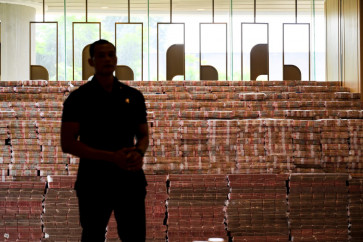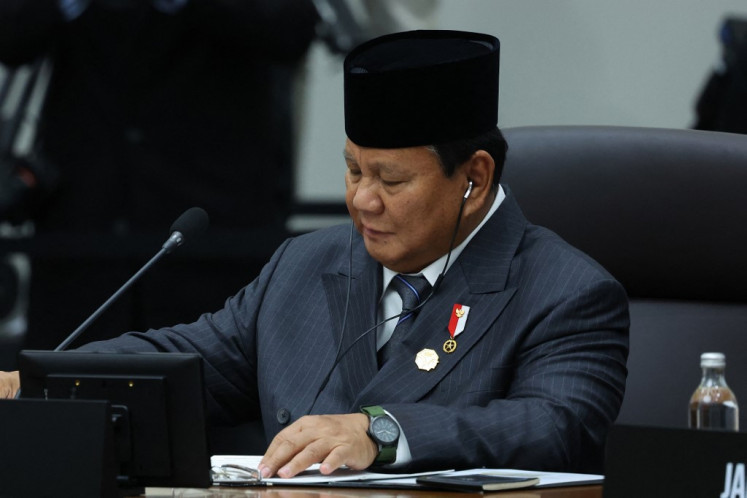Popular Reads
Top Results
Can't find what you're looking for?
View all search resultsPopular Reads
Top Results
Can't find what you're looking for?
View all search resultsAnalysis: Indonesian economy: Tough times ahead
Private consumption growth of below 5 percent year-on-year (yoy) in the second quarter of this year and declining imports in July (down 28 percent yoy) affirm our view of continued weak domestic demand and investment
Change text size
Gift Premium Articles
to Anyone
Private consumption growth of below 5 percent year-on-year (yoy) in the second quarter of this year and declining imports in July (down 28 percent yoy) affirm our view of continued weak domestic demand and investment. That said, the tight monetary policy of the past two years should continue to result in economic moderation through the first quarter of 2016.
Region-wise, we expect the commodity economy outside of Java to persist with lower growth amid soft commodity prices. At this point, room for a Bank Indonesia (BI) rate cut to spur growth still appears limited, as the Indonesia-US real interest rate gap remains small. Historically, a recovery has often followed a negative output gap by three to four quarters (table 1).
The government recently announced its proposed 2016 state budget, which includes Rp 1.8 quadrillion (US$128 billion) in government revenue (up 5 percent yoy). The target looks high, as assuming a Rp 250 trillion shortfall in 2015, we estimate that tax revenue would have to jump 26.4 percent in 2016 to achieve that target (table 2). A higher regional transfer portion is an interesting aspect of the new budget, leading to greater unpredictability in terms of execution risk.
The International Monetary Fund has cut its 2015 GDP growth forecast for emerging economies to 4.2 percent from 4.6 percent in 2014 on lower commodity prices and tightening global financial conditions. For Indonesia, lower oil prices are already having a positive net effect on the external trade balance, as the current account deficit (CAD)-to-gross domestic product (GDP) ratio was only 2.1 percent in the second quarter of 2015 (from 3.1 percent in 2014).
We estimate that every 10 percent drop in oil prices would increase the monthly trade balance by $78 million. That said, even though the second quarter trade balance was a net positive, continued steep export drops (July: minus 19.2% yoy) and ever lower Indonesian shares of global markets are restraining the country's ability to generate sufficient foreign reserves to finance external debt.
Indonesia is currently the only country with above 5 percent yoy inflation among its peers (table 3), caused by several increases in fuel price since 2013. In terms of purchasing power parity (PPP), this is why the rupiah has depreciated the most among these countries.
Technically, without another supply shock, we believe inflation should be below 5 percent at the end of 2015, but we see a possible upside from the recent El Niño weather pattern and possible additional fuel price increases in September/October. In our view, a manageable inflation level is imperative to prevent a vicious circle of currency depreciation and high inflation.

The rupiah's recent depreciation has raised concerns about foreign debt payments and the sufficiency of foreign reserves, which now cover just 6.9 months of imports. We remain cautious on this issue; second quarter private external debt growth has slowed, but remains high at 9.7 percent yoy (from 13.4 percent in the first quarter this year). However, BI's tightening policy, in place since 2013, has normalized the external balance. Moreover, current national debt levels are still far from 1998's recession levels.
Looking ahead, we cut our 2015 GDP growth forecast to 4.7 percent (from 4.9 percent) on softer-than-expected commodity prices, global market uncertainty, Chinese yuan devaluation and continued tight domestic monetary policy.
For 2016, we expect GDP growth to rebound modestly to 5.1 percent (from 5.3 percent previously), together with a possible BI easing policy. Next year, the biggest risk to our call will be the Fed rate hike, which remains as an overhang and could last until March-April 2016, based on analysts' expectations (table 4) following the yuan's devaluation.


_________________________________
The writer is an economist at Bahana Securities.










